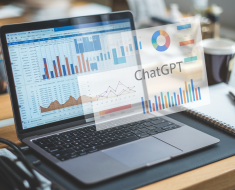Can you tell the difference between a masterpiece made by a human and one crafted by a computer?
Ever seen a piece of art that completely blew your mind? The colors, the composition, the sheer creativity of it all. Now, imagine finding out that this masterpiece wasn’t the work of a human artist, but a computer. Sounds a bit wild, right? Well, get ready to dive into the fascinating world of artificial intelligence arts.
AI isn’t just about Siri and self-driving cars anymore. It’s made its way into the art world, and it’s not just adding cool filters to your photos. We’re talking about AI algorithms creating original paintings, composing music, and even sculpting. These aren’t just random scribbles, either. Some AI-generated artworks have been sold for thousands of dollars and even displayed in famous galleries. It’s like a computer trying to pass a creativity test.
Artificial Intelligence Arts: More Than Just a Popular Tool


You’ve probably played around with AI-powered filters on social media or used apps that turn your photos into “masterpieces.” But artificial intelligence arts goes way beyond that. We’re now seeing AI algorithms that can generate original artwork from scratch. Imagine typing in a few words or a short description, and the computer creates a unique painting or melody based on your input.
Remember the portrait of Edmond de Belamy, which sold for a whopping $400,000 at auction? That was made by an AI. Even big-name auction houses like Christie’s have started selling AI art. It’s a whole new world for artists and art lovers alike.
The Visual Turing Test: Spot the Imposter


So, can you actually tell the difference between a work of art created by a human and one crafted by a computer? That’s where the Visual Turing Test comes in. It’s like a game of “spot the fake,” but with art. The goal is to figure out which pieces are AI-generated and which are the real deal.
There are a few ways this could work. Imagine an online survey with a bunch of artworks, some made by humans, others by AI. Could you tell them apart? Or picture an art exhibition where some pieces are labeled as “AI-generated” and others aren’t. Would the results surprise you?
The Visual Turing Test isn’t just a fun game; it’s a way to explore the limits of AI’s creative abilities and our own perceptions of what makes art “art.” Can a computer truly be creative, or is it just copying human artists? It’s a question that sparks a lot of debate and curiosity.
Think you can spot the difference between human and AI-generated art? Put your skills to the test and take our Visual Turing Test now!
Why It Matters: The Intersection of Art and Artificial Intelligence


The rise of artificial intelligence arts is a big deal. It’s not just about the cool factor of seeing what a computer can create. It’s about the future of art itself.
Artificial intelligence arts is pushing the boundaries of what’s possible. It’s opening up new ways to create and experience art. Plus, AI tools could make art creation more accessible to everyone, not just those with years of training. Imagine a world where anyone can generate a beautiful painting or compose a catchy tune with the help of AI.
Of course, there are challenges and controversies too. Who owns the copyright to AI-generated art? Could AI replace human artists altogether? And what does it mean for the art market and the value of art? These are big questions that we’re still figuring out.
The Future of Artificial Intelligence Arts: A Collaborative Effort


The future of artificial intelligence arts is likely to be a collaborative one, with artists and AI working together. Some artists already use AI as a tool to brainstorm ideas, generate variations, or even complete parts of their artwork. It’s like having a creative assistant who’s always ready to help out.
AI could also lead to entirely new forms of artistic expression that we haven’t even imagined yet. Think interactive art installations that respond to your emotions or music that changes based on your mood. It’s an exciting time to be an artist or an art lover.
So, what does this all mean for artists? It means adapting to the changing landscape and embracing new tools and technologies. AI isn’t here to replace artists; it’s here to give them new ways to express themselves and connect with audiences. It’s about finding new ways to thrive in a world where creativity knows no bounds.
Please note, that the author may have used some AI technology to create the content on this website. But please remember, this is a general disclaimer: the author can’t take the blame for any mistakes or missing info. All the content is aimed to be helpful and informative, but it’s provided ‘as is’ with no promises of being complete, accurate, or current. For more details and the full scope of this disclaimer, check out the disclaimer page on the website.





